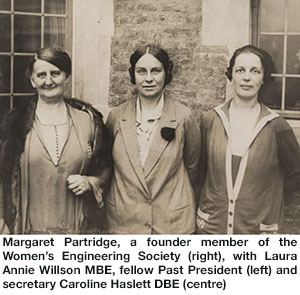100 years, 100 women engineers
07/11/2019
A list of 100 women engineers from history has been released as part of a project to celebrate the achievements of women in engineering over the past 100 years.Exactly a century ago, in 1919, an organisation called the Women’s Engineering Society (WES) was formed to inspire, support and encourage women to become engineers, technicians, electricians, motor mechanics, construction workers, pilots, machine shop operatives, draughtswomen and every other type of engineer you can think of. 100 years later, the many women who excelled, often against the odds, in these professions, which often deliberately excluded women, are being celebrated. The 100 Years of Women in Engineering campaign has identified the top 100 women engineers who have been influential in the UK in all engineering fields, who lived at some time between 1919 and 2019, and who are no longer with us.
The list includes founders of the Women’s Engineering Society, such as Rachel Parsons and Laura Annie Willson MBE, and its first secretary, Caroline Haslett DBE, as well as presidents of the society, including the pilot and engineer Amy Johnson and the founder of the Electrical Association for Women, Mabel Matthews. It includes well-known women from the Second World War period, such as Tilly Shilling, who developed the valve that prevented Merlin engines stalling when diving, and Hilda Lyon, who developed the ‘Lyon Shape’ used for the R101 airship.
 In the words of judge Nina Baker, who was part of a recent heritage project to erect a blue plaque to commemorate the life of Hilda Lyon in Market Weighton: “It would be lovely if local heritage groups could pick up some of these women and celebrate their lives through the Heritage Blue Plaque scheme in the same way as Hilda Lyon and Laura Annie Willson have been commemorated during the past year.”
In the words of judge Nina Baker, who was part of a recent heritage project to erect a blue plaque to commemorate the life of Hilda Lyon in Market Weighton: “It would be lovely if local heritage groups could pick up some of these women and celebrate their lives through the Heritage Blue Plaque scheme in the same way as Hilda Lyon and Laura Annie Willson have been commemorated during the past year.”The list also includes groups of women, including the unnamed construction workers who rebuilt Waterloo Bridge during the Second World War, also known as the Ladies’ Bridge, which opened in 1945, and the women of Bletchley Park, whose stories are coming to light at the moment.
Among more recent examples are Baroness Platt of Writtle, who has been a champion of women in science and engineering and whose work contributed to the establishment of the WISE campaign in 1982, and Elizabeth Killick, the first female fellow of the Royal Academy of Engineering, who died in August this year.
The list coincides with publication of a book charting the early years of the Women’s Engineering Society. Magnificent Women and their Revolutionary Machines by Henrietta Heald tells the stories of these pioneering women and their influence on the engineering landscape during a discouraging time for women in this male-dominated profession when, in spite of their tremendous work in munitions factories during the First World War, a successful attempt was made to outlaw the employment of female engineers.
Prominent physicist Jess Wade describes the book as: “a remarkable tribute to the pioneers who paved the way for modern Britain,” serving as a reminder of “how far women have come, and a source of inspiration for how far we still need to go.”
According to Dawn Bonfield, chair of the panel that chose the 100 women and Past President of the Women’s Engineering Society: “It has been inspiring to learn more about these magnificent women who were pioneers in their field and had to contend with not only a legal system that prevented their participation, but an engineering profession that made it very difficult for women to succeed in the workplace. Despite these hostile conditions, many women did thrive, and that makes their stories even more compelling. Thankfully our profession has changed enormously in the past 100 years, and we can celebrate our progress through learning more about the achievements of our predecessors.”
The stories of women from our science and engineering history are slowly emerging and being added to Wikipedia and other websites, such as the Magnificent Women website, in an attempt to reclaim our engineering heritage and use these inspiring stories to encourage future generations, where the percentage of women in engineering is still only 12%. The majority of these women on the list now have an online presence, but there is still much more work to do.
www.magnificentwomen.co.uk